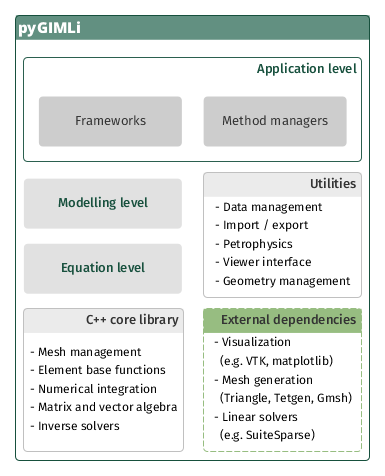Software design#
In applied geophysics, a lot of research efforts are directed towards the integration of different physical models and combined inversion approaches to estimate multi-physical subsurface parameters. Such approaches often require coupling of different software packages and file-based data exchange. The idea of pyGIMLi is to present a very flexible framework for geophysical modelling and inversion, which allows standard and customized modelling and inversion workflows to be realized in a reproducible manner.
The software is written in Python on top of a C++ core library, which allows a combination of flexible scripting and numerical efficiency. pyGIMLi uses selected external dependencies for quality constrained mesh generation in 2D (Triangle) and 3D (Tetgen) and visualization in 2D (Matplotlib) and 3D (Paraview) for example. For solving linear systems we use the open-source collection SuiteSparse [Chen et al., 2009], which contains multi-frontal direct and iterative solvers as well as reordering algorithms.

pyGIMLi is organized in three different abstraction levels:
- Application level
In the application level, ready-to-use method managers and frameworks are provided. Method managers (
pygimli.manager) hold all relevant functionality related to a geophysical method. A method manager can be initialized with a data set and used to analyze and visualize this data set, create a corresponding mesh, and carry out an inversion. Various method managers are available inpygimli.physics. Frameworks (pygimli.frameworks) are generalized abstractions of standard and advanced inversions tasks such as time-lapse or joint inversion for example. Since frameworks communicate through a unified interface, they are method independent.
- Modelling level
In the modelling level, users can set up customized forward operators that map discretized parameter distributions to a data vector. Once defined, it is straightforward to set up a corresponding inversion workflow or combine the forward operator with existing ones.
- Equation level
The underlying equation level allows to directly access the finite element (
pygimli.solver.solveFiniteElements()) and finite volume (pygimli.solver.solveFiniteVolume()) solvers to solve various partial differential equations on unstructured meshes, i.e. to approach various physical problems with possibly complex 2D and 3D geometries.